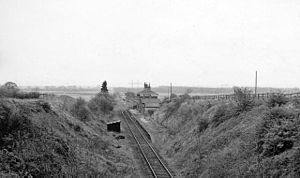
Knaresborough railway station is a Grade II listed station serving the town of Knaresborough in North Yorkshire, England. It is located on the Harrogate Line 16.75 miles (27 km) west of York and is operated by Northern Trains, who provide all passenger train services.
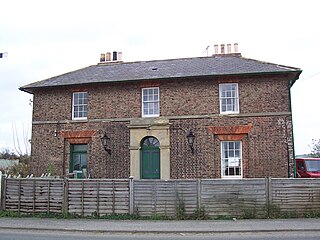
Weaverthorpe railway station was a minor railway station serving the village of Sherburn in North Yorkshire, England. Located on the York to Scarborough Line it was opened on 5 July 1845 by the York and North Midland Railway. It closed to passengers on 22 September 1930.

Milby is a hamlet and civil parish in the Harrogate district of North Yorkshire, England. It is situated to the immediate north of Boroughbridge.

Staveley is a village and civil parish in the Harrogate district of North Yorkshire, England. It is situated 4 miles (6.4 km) north of Knaresborough and near the A1(M) motorway. In the 2001 census, the village had a population of 444, which had risen to 450 by the time of the 2011 census. In 2015, North Yorkshire County Council estimated the population to have dropped to 440.

Staithes railway station was a railway station on the Whitby Redcar and Middlesbrough Union Railway, serving the villages of Staithes and Dalehouse in North Yorkshire, England. It was opened on 3 December 1883.

Helmsley railway station served the market town of Helmsley in North Yorkshire from 1871 until 1964, although the regular passenger service ceased in 1953. Helmsley station was nearly 15 miles (24 km) from pilmoor station on the East Coast Main Line, and 12 miles (19 km) from Pickering.

Husthwaite Gate railway station is a disused railway station in North Yorkshire, England. It served the nearby village of Husthwaite.

The Nidd Valley Railway was a 11.5-mile (18.5 km) long single track branch railway line that ran along the valley of the River Nidd in North Yorkshire, England. Built by the North Eastern Railway, it ran from Ripley Junction, on the Harrogate to Ripon Line, to Pateley Bridge via five intermediate stations, Ripley Valley, Hampsthwaite, Birstwith, Darley, and Dacre.

The Leeds Northern Railway (LNR), originally the Leeds and Thirsk Railway, was an English railway company that built and opened a line from Leeds to Stockton via Harrogate and Thirsk. In 1845 the Leeds and Thirsk Railway received permission for a line from Leeds to Thirsk, part of which opened in 1848, but problems building the Bramhope Tunnel delayed trains operating into Leeds until 1849.

Pilmoor railway station was in North Yorkshire, England, from 1847 to 1958, at the junction of the Great North of England Railway and the Pilmoor, Boroughbridge and Knaresborough Railway, about 6 miles (10 km) south-southeast of Thirsk at the southern edge of the civil parish of Sessay. The scattered settlement of Pilmoor, from which its name was derived, is located southwest of it.
The East and West Yorkshire Junction Railway was a railway company established in 1846 between the Leeds and Thirsk Railway at Knaresborough and the York, Newcastle and Berwick Railway near York, England. The company merged into the York and North Midland Railway in 1852.

The Thirsk and Malton line was a railway line that ran from a triangular junction on what is now the East Coast Main Line and served eight villages between Thirsk and Malton in North Yorkshire, England. The line was built after a protracted process due to inefficiencies and financial problems suffered by the then York and North Midland Railway.
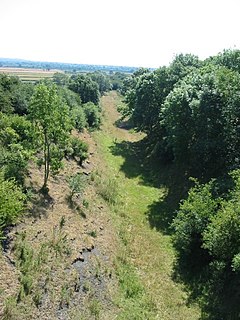
The Gilling and Pickering line (G&P) was a railway line that ran from Gilling to Pickering in North Yorkshire, England.

Brafferton railway station served Brafferton, North Yorkshire, England, from 1847 to 1964 on the Pilmoor, Boroughbridge and Knaresborough Railway.

Boroughbridge railway station served the town of Boroughbridge, North Yorkshire, England from 1847 to 1964 on the Pilmoor, Boroughbridge and Knaresborough Railway. The original station was a terminus with an east facing line, heading towards Pilmoor Junction on the East Coast Main Line. In 1875, the line was extended westwards to meet the line at Knaresborough.

Copgrove railway station served the village of Copgrove, North Yorkshire, England from 1875 to 1964 on the Pilmoor, Boroughbridge and Knaresborough Railway.

Goldsborough railway station served the village of Goldsborough, North Yorkshire, England from 1850 to 1965 on the Harrogate line. The station was over 13 miles (21 km) west of York railway station, and nearly 3 miles (4.8 km) east of Knaresborough.
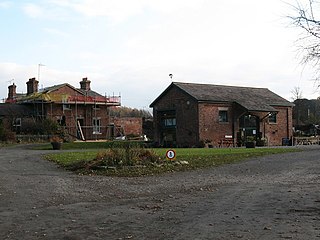
Masham railway station was the terminus of the Melmerby to Masham branch line serving the town of Masham in North Yorkshire, England. It was on the eastern side of the River Ure, so as such, was actually in Burton-on-Ure. The line operated between 1875 and 1931 for passenger traffic, but was retained for minimal freight train use until 1963.
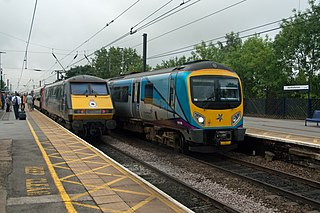
The network of railways in Northallerton, North Yorkshire, England, was constructed by three companies whose lines through the town were built between 1841 and 1852. They were all amalgamated into the North Eastern Railway (NER) which in turn was subsumed into the London and North Eastern Railway in 1923 and British Rail in 1948. British Rail closed two lines, the Wensleydale line in 1954 and a section of the Leeds Northern Railway to Harrogate in 1969. The Wensleydale line was retained as a freight branch and resurrected as a heritage railway in 2003 but the line to Harrogate closed completely. Despite closures and rationalisation, the station still is at a major junction on the East Coast Main Line.

Monk Fryston railway station was a railway station serving the village of Monk Fryston in North Yorkshire, England. Previously, Milford Junction and Old Junction served as an interchange between the Leeds and Selby and the York and North Midland Lines, however when they closed in the early 1900s, Monk Fryston was opened to cover for this loss of interchange. Though the station had four tracks through it, it only ever had two platforms. The station closed to passengers in 1959, and then completely in 1964.
